Declaration of Educational Goals: Metaphors
 MCEETYA
MCEETYA are seeking input on the new
National Declaration on Educational Goals for Young Australians for the next decade. See
previous post.
The draft document calls for the development in Australia of
"world-class curriculum and assessment". Although I understand the intent I question the metaphor and therefore the possible underlying assumptions.
While previous declarations have been about
'schooling' the current document moves to
'education'. This is a welcome and significant shift away from 19
th century metaphors and thinking that were designed to support industrialisation.
But which school of thought does '
world-class' sit in? We need to be careful that 19
th century metaphors are not being simply re-badged leaving unquestioned assumptions to drive thinking.
For example, when the document refers to the need for "quality teachers" it also talks about
developing the
right people to be effective
instructors to
deliver the
best possible
instruction! Aren't we committed to personalised learning for all young Australians?
The document says teachers should have "targeted professional development... to enhance teaching and learning." Shouldn't they be engaged with "personalised professional learning... to enhance learning, teaching and assessment" ?
Laying solid foundations is another metaphor that needs questioning... The notion of providing foundations for later learning appears frequently in the document. Combined with the need for essential literacy and numeracy (also frequently cited) and the need to meet national standards this has the potential to alienate many of the learners we are attempting to engage.
Some learners spend years - even decades - in dark educational foundations...
We understand the brain/mind and learning a little better now. Laying foundations, building learning structures, sequential processes and other 19
th C metaphors are not always the most appropriate...
We also need to question our
curriculum metaphors. The document talks about a "comprehensive curriculum that
details the knowledge, skills and values to be achieved." Is this '
curriculum as content' where "specified work needs to be covered" ? Or are we talking about more dynamic
curriculum frameworks that remains current in times of rapid change?
While the document has much to offer it still appears to be caught between the 19
th and 21st centuries - neither in one nor the other...
But then so are we :-)
.Labels: 21stCentury, conceptual frameworks, curriculum, engagement
Doing IT Differently - F: Conceptual Frameworks
What will be different at
HC in 2008?
F: Conceptual FrameworksThe shift in focus from information to
knowledge and understanding - and even wisdom - has emphasised the need to
highlight concepts, conceptual lenses and conceptual frameworks in curriculum design - as well as learning and teaching. (
eg see
Concept-Based Curriculum and Instruction by Erickson)
However, although
conceptual frameworks are used by educators in research and curriculum design they are not as often given to students to help them make their own connections.
Over the last few years a number of
colleagues have supplemented their teaching of the usual
topic or subject based concepts (
eg 'values', 'texture', 'evolution' or 'sustainability') with more
integrative frameworks such as
Senge's 'systems framework', Gardner's
'multiple intelligences framework' and
Wilber's 'four-quadrant framework'. The
response from students has been very positive.
 In 2008
In 2008 we plan to introduce integrative frameworks to computing students - particularly those doing interactive media involving Student Directed Inquiry (see
previous post). We will continue to use integrative
conceptual frameworks with students in English, Media and our academic achievement program.
Integrative conceptual frameworks help students to:
- move their thinking to the metacognitive level - thinking about thinking
- make sense of transdisciplinary inquiry - required in the Student Directed Inquiry course
- make connections to their existing knowledge and understanding
- know what they don't know - and know where to find out
- transfer learning to new situations - and cope with rapid change
- understand the importance of worldviews - and the need for collaborative inquiry
Exactly how we will use integrative conceptual concepts with computing students still needs to be worked out...
Previous - E: Assessment of, for and as Learning Next - F: Blended Learning
Labels: conceptual frameworks, integral, learning, metacognition, structure, teaching, transdisciplinary
Integrating Science and Soul in Education
 Sue
Sue has just completed a great presentation on Science and Soul for the upcoming
CONASTA ICASE conference in Perth. It's in two parts and is 25 mins long. Great visuals!
Part 1:

Part 2:

Labels: conceptual frameworks, integral, learning, spirituality, sustainability, systems, teaching, worldviews
Integrating Science and Soul in Education

My wife has just put her recently completed thesis online!
To quote from her abstract:
"This is an auto-ethnographic study into the lived experience of a science teacher as she attempts to transform her science teaching practice and the practice of other science teachers over a period of 15 years. In exploring what it means to be a holistic educator she is faced with disorienting dilemmas which cause her to question underpinning assumptions, values and curriculum frameworks which inform traditional science teaching practice and culture. In trying to reconcile science and soul in the pedagogical space of a physics classroom her journey requires a deep investigation of self in various cultures – science culture, educational culture, modernist and postmodernist cultures."
Phenomenal work!
Labels: conceptual frameworks, curriculum, holistic, integral, learning, spirituality, teaching, transdisciplinary, transformation
Knowledge and Slowness in Learning
Knowledge workers need to know how to use
tools and frameworks to do their jobs according to Charles Jennings, Global Head of Learning at Reuters UK. Jennings painted a clear picture of the way workplaces have changed over the last 20 years on day 2 of the
Global Summit 2006 in Sydney:
- 70% of jobs created in the USA since 1998 have been for "knowledge workers"
- "knowledge worker"jobs now make up 41% of all jobs in the USA (2005)
- only 20-30% of workplace performance is knowledge/skills related (2005)
- people learn 80% of what they need to know informally on-the-job
He cited Kelley's longitudinal study showing how the amount of knowledge that we need to know in our own minds to do our jobs has changed: 1986 - 75% ... 1997 - 15-20% ... 2006 - 8-10%
Jennings spoke of the need to shift from training to learning; of the need to know less and learn more; of the need for workers to have tools and frameworks to locate and process what they need to know when they need to know it.
And now for something completely different...
Geetha Narayanan from the School of Art Design and Technology, India presented two concepts. The first was the importance of digital story telling - showing how young disadvantaged people can be empowered to use cameras and recorders to tell their own powerful stories. And to tell them so well that they win international competitions.
 The second was the notion of "slow schools". Narayanan spoke of the importance of health and well-being among today's technology rich, fast-paced and consumer oriented middle-class learners. The slow school idea was spawned by the slow food campaign which began as a protest against fast-food outlets but is rapidly becoming a global movement and has recently been popularised by TV chef Jamie Oliver as slow food moves into schools and begins to transform education...
The second was the notion of "slow schools". Narayanan spoke of the importance of health and well-being among today's technology rich, fast-paced and consumer oriented middle-class learners. The slow school idea was spawned by the slow food campaign which began as a protest against fast-food outlets but is rapidly becoming a global movement and has recently been popularised by TV chef Jamie Oliver as slow food moves into schools and begins to transform education...
Slow schools look for opportunities to slow the pace of thinking and move to being in the moment. Narayanan gave examples of moving students from thinking about the sun to embodying and being the sun as they sit in circles with feet touching, or slowly draw 10 suns rather than one, or as they dance watching sunrise...
Slow schools allow time for discussion and reflection - and focus on how students form concepts and make meaning.
 Co-incidentally my blog reading recently introduced me to "slow design" and "slow cities" - the latter is already a network of 100 towns in 10 countries embodying the 'slow' metaphor.
Co-incidentally my blog reading recently introduced me to "slow design" and "slow cities" - the latter is already a network of 100 towns in 10 countries embodying the 'slow' metaphor.
Perhaps this brings new meaning to the concept of the slow learner :-)
Labels: 21stCentury, conceptual frameworks, transformation
Designing Courses: Learning Areas and Capabilities
I've been playing with models that might clarify the process of designing courses in order to provide for
all students under the new Post Year 10 Curriculum Framework for Tasmania. I've also been reading about the
current call for a "back to basics" national curriculum and in particular thinking about
Alan Reid's proposal's in
Rethinking National Curriculum Collaboration - but within a State rather than national context.
(School education is the constitutional responsibility of the States in Australia.)Before the current PY10 Curriculum Framework was developed the structure of the curriculum was hard to conceptualise. In the late 80s and early 90s traditional subjects were loosely grouped into 'learning areas'; new programs to support literacy, numeracy and ICT literacy were developed; new courses emerged and some stayed; student support, health and well-being and career/pathway options evolved; key competencies/capabilities were identified...
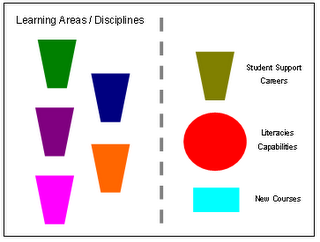
However much of this sat outside traditional subjects/leaning areas - conceptually and often in implementation as well - or sometimes uneasily within syllabuses and timetables as attempts were made to "embed them".
Syllabus development most often occurred within subject/learning areas and tended to reinforce existing knowledge structures, ways of learning, teaching and assessment. New courses often failed to gain a foothold if they did not fall neatly into traditional ways of organising knowledge.
The new PY10 Curriculum Framework is based on agreed values and purposes arrived at during a long period of co-construction. We are currently looking at the structures and processes that might inform the provision of courses within the Framework. What range of courses will be available to choose from?
While we now have a State Curriculum Framework individual year 11/12 schools will be responsible for implementation to meet student needs in local contexts. Which courses will schools choose to offer their students? And how will individual classroom teachers interpret these courses?
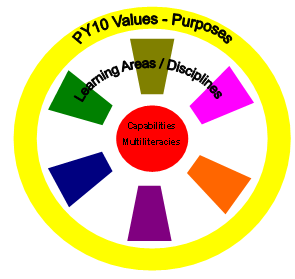
(NB In this graphic the number of learning areas is arbitrary.)
A key question at the moment is what sits between the values and purposes and the capabilities/literacies? What are the contexts for learning? Can we move away from learning areas? Should we move away from learning areas? Following Reid's suggestion (in the above paper) can we develop courses where students learn for the capabilities through the learning areas - leaving the details of what learning to schools, teachers and students?

Or will existing ways organising knowledge/skills and their associated communities of practice work against providing opportunities to develop all the capabilities required for the 21st century? Will anything really change if traditional learning areas still dominate structures and processes for course/syllabus development.
And where do transdisciplinary approaches fit? How do we move beyond disciplines to engage in the kind of rigorous thinking that is needed to meet today's societal and planetary challenges? Can we construct valued learning experiences/courses that exist in the space between the disciplines and their well developed resources/support structures/dialogues?
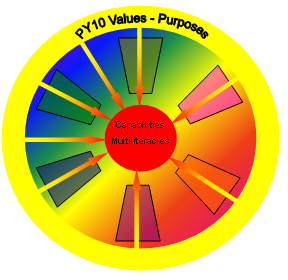
Perhaps we need to use other lenses/conceptual frameworks to help us create courses/learning experiences that help students to make meaningful connections beyond subject borders and to "know what they don’t know". Can we generate meaningful content/contexts by asking the big questions? Is an 'integral' lens useful as a conceptual framework?

Perhaps course developers and classroom teachers (hopefully the same people) need to draw on a course development toolbox containing a variety of conceptual lenses... A learning ecology/connectivism framework such as the following by George Siemens that looks at "know where" as well as "know-how" and "know-what" might be one tool.

And how can we establish course developement models/principles that ensure the ongoing currency of courses in today's rapidly changing world?
Labels: 21stCentury, conceptual frameworks, curriculum, learning, literacies, transdisciplinary
Transformational Leadership Frameworks
Five Conceptual Frameworks for transformational leadership focussing on "generating the breakthrough insights needed to generate new commitments, behaviour, and results for individuals, institutions and societies."
I've just read Monica Sharma's article in the latest issue (No.12) of
shift from
IONS. She describes an
integrated "transformative leadership" methodology she helped develop for the
United Nations Development Program in 2001. Her
Transformative Leadership Development Program (2005) has now reached 4.5 million people across 40 countries with a particular focus on creating leadership capacity to help countries respond to HIV/AIDS.
According to a report on the
UNDP European website the Five Conceptual Frameworks provide easily transferrable tools for transformation that have been effective at all levels of society and across diverse cultures.
What would happen if we used these tools for educational change? And also for empowering students as we promote global citizenship?
Sharma's
five frameworks for transformative leadership (
Annexes 3) are:
- Leadership Competencies and Distinctions
- Emotional Intelligence Framework - based on the work of Daniel Goleman
- Four-Quadrant Framework - based on the work of Ken Wilber
- Levels of Organisational Development - based on the work of Rensis Likert
- Dynamic Strategic Planning Processes - based on appreciative inquiry
These frameworks are used within a systems thinking approach based on the work of Peter Senge.
According to Sharma the frameworks provide conceptual maps that "suggest ways of perceiving, understanding, and interpreting the world that may be different from our usual conditioning."
She says the Transformative Leadership Development Program (TLDP)
"emphasizes that the level of learning necessary to develop transformational leaders goes beyond sharing theories, learning new techniques, or gathering information. It is a process that actually works at a level deep enough to discover and shift who people are being, not what they know; it is for individuals who are ready and willing to be learners and to engage in a process of profound personal growth."
Sounds like something we need in our education systems... :-)
I like the way the TLDP not only uses coherent conceptual frameworks as a kind of holistic lens that highlights multiple aspects of an issue, but also the way several frameworks are integrated to provide a multidimensional picture of a system... hopefully giving a better chance for sustainable systemic change.
Which frameworks/tools would best facilitate educational transformation? Would the same set also be appropriate for students involved in leadership?
Perhaps Gardner's Multiple Intelligences Framework could be added to Goleman's Emotional Intelligence Framework? Perhaps Grave's Spiral Dynamics could be added to Likert's framework? Perhaps Senge's U-Process could be added to the strategic planning processes?
There is certainly no shortage of tools! Do we know how to use them? Can we afford not to use them?
Sources:
Sharma, M (2006) Conscious Leadership at the Crossroads of Change in shift (No.12): IONS
UNDP Report Annexes 3 - Accessed from UNDP European website on 17th Sept. 2006
Labels: conceptual frameworks, leadership, transformation
Curriculum as Connectivism
I've been reading with interest
George Siemen's blog and
wiki on
'connectivism' talking about learning as network creation and how we might provide
'learning ecologies' to meet the needs of students. I'm finding these concepts very useful as we look at planning the implementation of the new Curriculum Framework. But before I launch into that I've been trying to place connectivism as a curriculum metaphor within an Integral AQAL Framework... particularly after reading his last post
revisiting a discussion on subjectivity and objectivity.
I've looked at this before with some simplistic (perhaps too simplistic) mappings of other curriculum metaphors onto
Ken Wilber's subjective/objective/individual/collective quadrants (270Kb). The different colours refer to
waves from Spiral Dynamics... Blue as rule-self, orange as achiever-self, green as sensitive-self, yellow as integral-self... but I'm mostly interested in which quadrants these metaphors map into... at least in the way they have usually been implemented.
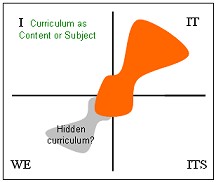 Curriculum as Content or Subjects:
Curriculum as Content or Subjects: This metaphor portrays a traditional image of curriculum that stretches back to Pythagoras and Plato. This curriculum is one which receives contents from traditional academic disciplines and transmits them to the learner.
Intent: Curriculum development centres largely on subjects, contents, timetables and booklists. Needs may be defined in terms of preparation for university, commerce or general study.
Criticism: Does not account for cognitive development, creative expression, and personal growth. Nor for planned and un-planned activities that are a major part of students’ experiences at school.
 Curriculum as Discrete Tasks and Concepts:
Curriculum as Discrete Tasks and Concepts: The curriculum is seen as a set of tasks to be mastered and is derived from training programs in business, industry and the military.
Intent: ‘Apprenticeship’ with an adult to gain certain knowledge and skills.
Criticism: Does not prepare the learner for a changing world. Suited to technical training rather than conceptual understanding.
 Curriculum as Experience:
Curriculum as Experience: This image of curriculum, following John Dewey, emphasizes experience rather than sets of activities. Learners select a learning experience according to its significance in their life.
Intent: With this notion of curriculum, the learners have a key role in curriculum process. Experiences are created as learners reflect on the learning process.
Criticism: Students’ involvement in planning and selecting the learning experiences is very idealistic - they may not be able to decide which is of significance and which is not. How do you implement this in a large school?
 Curriculum as Cultural Reproduction:
Curriculum as Cultural Reproduction: The curriculum metaphor is concerned with the notion of transmission of cultural knowledge and values from one generation to another.
Intent: To prepare the youth for the culture of a certain community, state and country.
Criticism: Helps maintain the status quo by transmitting middle class culture rather than that of the oppressed. Does not help develop critical thinking.
 Curriculum as “Currere”:
Curriculum as “Currere”: The curriculum is the interpretation of the learner’s lived experiences – the learner comes to understand their past, how it drives the present and how it directs the future of their personal and professional life. Individuals come to a greater understanding of themselves, others, and the world about them.
Intent: Freedom from unwarranted convention, ideology and labelling. To mutually fashion new directions for oneself, others and the world.
Criticism: Self-understanding is a parental responsibility. The search for self-knowledge requires professional therapists.
 Curriculum as Intended Learning Outcomes:
Curriculum as Intended Learning Outcomes: This image sees the curriculum as a process of goal setting and drawing a pathways to those goals. The outcomes are expressed in general terms like “understanding the value of…”. Today most curriculum frameworks have incorporated this image.
Intent: The curriculum is explicit and defensible. Teachers and students can determine their learning activities according to their needs and locale.
Criticism: Draws attention away from unintended outcomes relating to school culture and the hidden curriculum.
So... how does one map curriculum as connectivism? At the moment my reading places it mainly in the ITS quadrant - grounded in an objective systemic worldview but taking into account issues of social constructivism (WE quadrant) with a span across blue/orange/green and possibly into yellow memes. A much broader span than the other metaphors...
 Curriculum as Connectivism:
Curriculum as Connectivism: This curriculum metaphor is related to networks and network topology. It takes a systems view of learners and sees learning as network creation.
Intent: To provide a ‘learning ecology’ that the student connects with as and when appropriate.
Criticism: Favours self-directed learners.
This is potentially a richer way of seeing curriculum provision and I'm now interested to see how this metaphor might inform our discussion of how students choose their learning, what structures we might put in place to provide learning ecologies and how we can support students to make the necessary connections... more on this later.
Our leadership team have already found Sieman's
Learning in Context powerpoint very useful (see also
this pdf paper) and I'm hoping to see him in Sydney later this year...
The above curriculum metaphors (apart from the last one) are sourced from: Schubert, W. H. (1986). Curriculum: Perspective, Paradigm, and Possibility. New York: Macmillan Publishing Company.Labels: conceptual frameworks, curriculum, integral
An Integral Part of Learning?
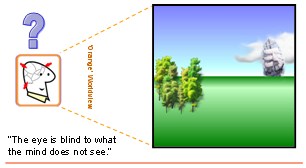 More than 60% of year 11/12 teachers would consider using Integral Theory with their classes!
More than 60% of year 11/12 teachers would consider using Integral Theory with their classes!
Yesterday Sue (my wife) and I had the privilege of presenting aspects of Integral Theory to 50+ year 11/12 teachers in a non-government school. In spite of being a warm late afternoon and the fact that we covered 8 concepts and associated 'jargon' in 2 hours we received very enthusiastic responses.
I was surprised to discover quite a few teachers had already read some of Ken Wilber's work and a couple had already used aspects of Integral Theory with their classes.
This was the first time we've presented Integral Theory to a larger group of teachers - I presented the same concepts to several classes (yr 11/12) last year. From the mixed teacher feedback for some sections the balance of breadth to depth needs some adjustment - although I still think that a reasonable breadth is necessary to appreciate the coherence of the integral framework. There was less time for teacher discussion than with students who had a 3hr session.
More than half of those present said that they thought the concepts would be useful/very useful in their teaching. Many requested follow-up discussion so that they can develop the ideas for their classes. Some of this will be done through on-line presentations and forums over the next few weeks (although I've discovered the forum link has broken over the summer holidays).
In the last 10 minutes we touched briefly on 'stages of development' and 'information/transformation'. In retrospect this may have been a mistake in such a short time - although one teacher indicated that this was the most important part of the presentation for them.
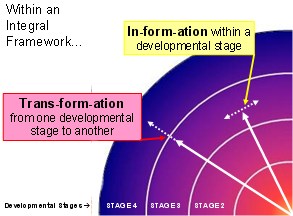
Next week I'll begin working with some of the classes of teachers in government yr 11/12 colleges that were involved in last year's trials. We are going to introduce students to Integral Theory from the start of the year (classes start tomorrow in Tasmania) and develop the concepts as they progress through their courses.
Labels: conceptual frameworks, integral, metacognition, teaching
Integral Futures
 All education is futures education
All education is futures education according to Australian futurist
Richard Slaughter. He says most schools are about preparing students for active citizenship in the future. And
"young people do not need to be persuaded to consider the future. They already have powerful interests in the self-constitution of their own lives."
However he also says:
"The challenge is to re-invent schools on a new philosophical and operational basis, not see them over-whelmed by economic rationalism, still less by the over-hyped 'communications revolution'. "
I'm reading Futures Beyond Dystopia: Creating Social Foresight by Slaughter and think it has much to inform current curriculum initiatives - particularly now in Tasmania with Personal Futures and World Futures 'essential learnings' for K-10 and Futures a key purpose in the new Post-Year 10 Framework.
To avoid shallow and often overly Westernised and empirical futures perspectives Slaughter calls for an integral approach to futures at all levels of education including students, teachers, curriculum leaders and administrators. "The need is for a broader and deeper view of futures enquiry."
'Integral futures' is about including subjective inner realities along with objective outer realities - something often called for by holistic educators. Slaughter shows how Wilber's 4 Quadrant AQAL Integral Model provides a powerful conceptual framework that gives breadth, depth and balance to futures literacy, futures methodologies and futures tools.
In this way the critical importance of looking at cultural values, assumptions and worldviews (lower left quadrant) and the inner world of individual identity, meaning and purpose (upper left quadrant) as key aspects of any transformational process is not forgotten.
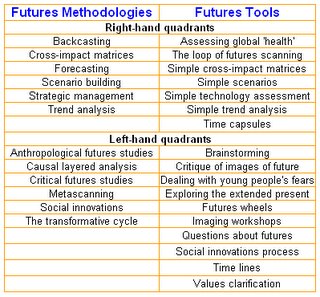 Slaughter maps pop futurism, problem-oriented futures work, critical futures studies, epistemological futures, and environmental scanning across Wilber's quadrants showing the strengths and gaps in each approach over the last century.
Slaughter maps pop futurism, problem-oriented futures work, critical futures studies, epistemological futures, and environmental scanning across Wilber's quadrants showing the strengths and gaps in each approach over the last century.
Of course with all this talk of futures we need to remind ourselves that futures education is about empowering students in the present - or better still perhaps in the 'NOW' which includes and expanded sense of past-present-future.
I recently saw this Alan Watts Flash presentation on an Integral Education Forum which graphically shows the dangers of always looking to (waiting for) the 'future'... well worth a look if you haven't seen it.
With the current global focus on transforming learning and teaching an 'integral futures' perspective seems timely as we look at possible, probable and preferred educational futures - lest we forget the critical place of both individual and collective inner realities... for both students and teachers.
Labels: 21stCentury, conceptual frameworks, integral, metacognition, worldviews
Student Feedback on Integral Theory
 Student response
Student response to
Integral Theory over the last few months has been very enthusiastic. Although you can't read the left hand column in the linked doc you can see from the feedback summary that I touched on many concepts over 2.5 hrs. Some a little too briefly perhaps but I think it is important for students to get a clear sense of the coherency of the overall framework.
So far I have only introduced it to Level 5 English classes but I know of teachers internationally who have received very positive feedback from grade 9 and 10 students... so I'm keen to try it with other classes next year.

I'm about to run similar sessions for teachers so it will be interesting to compare feedback... For teachers I am hoping Integral Theory will provide a coherent conceptual framework that helps to make sense of some fundamental concepts underpinning the
ELs and PY10 Frameworks such as: * Worldviews * Value systems * Systems Thinking * Disciplines * Transdisciplinary * Transformation *
Labels: conceptual frameworks, integral
Framework Mapping
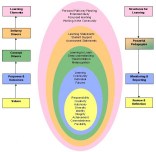
I've been playing with mapping the new curriculum framework... :-)
In this first one I have used a nested (holarchic) rather than hierarchic representation. I think holarchies better represent the notion of expansion and inclusion we might be after.
If you can't see it properly hold your mouse over it until you see the '<- expand ->' icon.
In the second version I have shaded the right hand side boxes to represent the notion that ALL stages are inclusive of ALL the curriculum principles - values to learning elements.
In the third version I have shown how extra words might be added to give some sense of the emergent whole for each level (called a holon). I am not happy with the words I have chosen but you get the idea...
The fourth version gets a bit more radical. I have changed some of the names trying to embrace different metaphors.
On this doc I have started to look at other ways of describing the Learning Elements (don't really like the word 'challenges'...) .
I have also included Professional learning because feedback was critical that teachers didn't seem to be represented. Others would say that the learning refers to boths students and teachers. Anyway... I just put it in to see what people thought.
Finally here is a version from John exploring the idea of turning the pancake diagram on its side...
What do you think? Useful? Clumsy?
Labels: conceptual frameworks, curriculum
To theorise or not to theorise...
After spending the last few months learning and talking about Integral Theory I finally have got to the point where I have begun to write about it a little more deeply. But this is no easy task!
Ken Wilber, who has done much to develop Integral Theory has been called the 'Einstein of Psychology' because aspects of the theory are as radically new as Einstein's theories in science were nearly 100 years ago. However I'm hoping that applying what Wilber and others have come up with is a little more straight forward.
I'm keen to promote discussion of Integral Theory because reports from teachers who are using it to design curriculu and courses are very positive. Many have also used it in their classes and some have great responses from students who found it has some useful tools for research, problem-solving, interdisciplinary inquiry and understanding self and others.
The paper I am writing sketches out some of the areas of Integral Theory that I would like to discuss for our college curriculum - but that took up 20 pages! Not quite the short introduction I was planning.
I have sent what I have written to a number of people locally and internationally and initial responses have been very positive. However while most believe that the information is important (and some believe even critical) to understanding education for years 11 and 12, views vary widely on whether teachers will have the time or inclination to look at such a theoretical perspective of curriculum.
Some believe all college teachers should read the paper and that most would find it very useful both in thinking about curriculum and in their own teaching practice. Others believe only a few teachers would want to look at it.
Wilber's integral perspective maps human experience across 4 quadrants.
The 4-Quadrant Integral Model provides a comprehensive map of human experience and capacities which is being applied to many fields of human endeavour including global ecology, business and organizational practice, medicine and international politics. If we put this in the context of student learning we obtain an integral map that might represent different domains of a curriculum:

Integral approaches to curriculum could provide:
- Frameworks for learning, research and problem solving processes
- Lenses to ensure structures and processes are more balanced and inclusive
- Tools for transformational change
- A common language for transdisciplinary inquiry
So... where to from here? Perhaps there are several possibilities.
- Some who have read the paper are already keen to form a group to discuss it in some depth.
- The paper could be made available for anyone who wants to read it.
- I have begun to break it down into small chunks - the first of which I have just sent as an email to all teachers at Hobart College and a few interested teachers in other colleges.
- Offer small lunch-time forums after Easter - perhaps after the next chunk goes out in another email.
In the meantime I will work on a second draft based on all the feedback I have received so far - thanks to all those who have sent me comments.
Labels: conceptual frameworks, curriculum, integral
 MCEETYA are seeking input on the new National Declaration on Educational Goals for Young Australians for the next decade. See previous post.
MCEETYA are seeking input on the new National Declaration on Educational Goals for Young Australians for the next decade. See previous post.






















 Slaughter maps pop futurism, problem-oriented futures work, critical futures studies, epistemological futures, and environmental scanning across Wilber's quadrants showing the strengths and gaps in each approach over the last century.
Slaughter maps pop futurism, problem-oriented futures work, critical futures studies, epistemological futures, and environmental scanning across Wilber's quadrants showing the strengths and gaps in each approach over the last century. 






